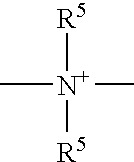Polycarbonate and/or polyurethane polyorganosiloxane compounds
a polyorganosiloxane and polyurethane technology, applied in the field of polycarbonateand/or polyurethanepolyorganosiloxane compounds, can solve the problems of inability to adapt the structure within wide limits to suit the concrete product requirements, inability to use isocyanate groups, and inability to meet the requirements of concrete products. flexible and flexible structure, novel interesting properties, and easy preparation
- Summary
- Abstract
- Description
- Claims
- Application Information
AI Technical Summary
Benefits of technology
Problems solved by technology
Method used
Image
Examples
example 1
[0336]5.2 g (0.022 mol) of a phenol ester of the structure
[0337]
49 g of an aminosiloxane of the structure
[0338]
and 15 g of 1-butanol are mixed in a flask under an N2 atmosphere and the mixture is heated at 120° C. for 9 hours, during which it reacts, with phenol being split off, to give a reaction mixture which contains the compound of the formula:
[0339]
2.04 g (0.02 mol) of H2NCH2CH2CH2N(CH3)2 are then added and the mixture is heated at 120° C. for a further 9 hours.
[0340]Finally, 2.59 g (0.01 mol) of an ester of the structure
[0341]
are added dropwise and the mixture is stirred at 120° C. for a further 18 hours.
[0342]As a result of the reaction, in addition to the phenol as the product split off, a polymer is obtained which contains the following structural element:
[0343]
example 2
[0344]7.36 g (8.04 mmol) of a carbonate-terminated polyalkylene oxide derivative of the structure
[0345]
where a+c=3.6 and b=9,
prepared from
[0346]
COCl2 and Jeffamin ED 600 (Huntsman Corp.),
1.69 g (16.1 mmol) of H2NCH2CH2CH2N(CH3)2 and 61 g of propylene glycol monomethyl ether are initially introduced into a flask under an N2 atmosphere and the mixture is heated at 116-118° C. for 15 hours, while stirring.
[0347]A mixture comprising 50 g (8.04 mmol) of an epoxysiloxane of the structure
[0348]
1 g of deionized water and 0.97 g (16.1 mmol) of acetic acid is then added. The total mixture is heated at 116-120° C. for 10 hours.
[0349]As a result of the reaction, a polymer is obtained which contains the following structural element:
[0350]
[0351]The polymers according to Examples 1 and 2 can be incorporated in an amount of 0.5-3% into pulverulent and liquid detergents based on anionic and / or nonionic surfactants, and exert there in particular their softening action on the fibre materials to be cle...
PUM
| Property | Measurement | Unit |
|---|---|---|
| temperature | aaaaa | aaaaa |
| particle diameter | aaaaa | aaaaa |
| viscosity | aaaaa | aaaaa |
Abstract
Description
Claims
Application Information
 Login to View More
Login to View More - R&D
- Intellectual Property
- Life Sciences
- Materials
- Tech Scout
- Unparalleled Data Quality
- Higher Quality Content
- 60% Fewer Hallucinations
Browse by: Latest US Patents, China's latest patents, Technical Efficacy Thesaurus, Application Domain, Technology Topic, Popular Technical Reports.
© 2025 PatSnap. All rights reserved.Legal|Privacy policy|Modern Slavery Act Transparency Statement|Sitemap|About US| Contact US: help@patsnap.com



